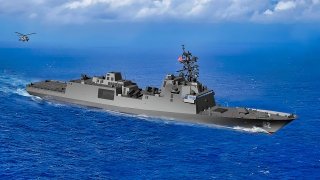The U.S. Navy's Constellation-Class Frigate Nightmare Is Sad
The U.S. Navy's procurement of the Constellation-class frigates has faced significant issues due to rushed oversight, as highlighted by the Government Accountability Office (GAO).
Summary: The U.S. Navy's procurement of the Constellation-class frigates has faced significant issues due to rushed oversight, as highlighted by the Government Accountability Office (GAO).
-The $22 billion program awarded Fincantieri a contract in April 2020 before the ship design was complete, leading to potential cost increases and delays.
-The GAO criticized the Navy for not demonstrating key systems and suggested land-based testing to mitigate risks.
-Delivery of the first ship, USS Constellation, has been delayed from 2026 to 2029, with costs projected to exceed initial estimates.
-Despite these setbacks, the Constellation-class frigates are expected to enhance the Navy's multidomain warfare capabilities significantly.
GAO Report: U.S. Navy's Constellation-Class Frigate Program Faces Major Delays and Cost Overruns
The U.S. Navy mishandled one of the largest procurement programs of recent years, according to the Congressional watchdog.
In a recent report, the Government Accountability Office (GAO) assesses that the Navy botched the procurement of the new Constellation class frigates because it was in a rush.
A Contract Too Soon
According to the GAO report, the Navy fell short on its oversight of the Constellation-Class Guided-Missile Frigate (FFG 62) Program, which is expected to cost approximately $22 billion.
In April 2020, the Navy awarded Fincantieri the initial contract for one plus nine frigates even though the design was incomplete. As such, costs could skyrocket before there is an operational capability.
“The frigate is using many mission systems already proven on Navy ships. However, the Navy has yet to demonstrate two systems—the propulsion and machinery control systems,” the GAO report stated.
“A planned update to the frigate test plan—combined with the opportunity afforded by schedule delays—could offer the Navy the chance to conduct land-based testing of these two unproven systems. This testing would reduce the risk of discovering issues after the ship is at sea,” the GAO report added.
To make matters even worse, Fincantieri is behind schedule with the first warship of the class, USS Constellation, and instead of delivering it on 2026 will have it ready by 2029.
In terms of costs, the new class of warships is expected to average at less than $1 billion per frigate. The USS Constellation is projected to cost approximately $1.4 billion, and in May the Navy awarded a $1 billion contract for an additional two Constellation frigates. In total, the Navy has ordered six ships as of June.
GAO has made several recommendations to the Navy that could get the program back on track. These proposals include a restructuring of the design stability metric to ensure quality over quantity; the use of an improved metric to better estimate the design stability before construction begins on the second frigate of the class; the identification of opportunities to improve the acquisition strategy; additional land-based testing of technology and systems.
The Constellation Class Frigates
Despite their cost, in terms of capabilities, the Constellation class frigates are going to boost the Navy’s ability to conduct multidomain warfare across the world. For example, the new warships will be able to operate in both open water, such as the open Indo-Pacific, and littoral, such as the first island chain, environments.
“This ship class will be an agile, multi-mission warship, capable of operations in both blue-water and littoral environments, providing increased combat-credible forward presence that provides a military advantage at sea,” the Navy states about its upcoming warship.

According to the Navy, the new class of frigates will be able to conduct surface warfare, anti-submarine warfare, air warfare, and electromagnetic warfare. As multirole warships, the Constellation frigates will be able to fill many gaps and potentially free up larger warships, such as destroyers, for more demanding missions.
To be effective in its role, the new frigates will pack quite an arsenal, including torpedoes, Enterprise Air Surveillance Radar (EASR), Baseline Ten (BL10) Aegis Combat System, and a Mk 41 Vertical Launch System.

Through the Constellation class, the Navy is reviving the concept of frigates. Although in use by many navies around the world, frigates have been absent from the Navy roster since the early 2000s when the last Oliver Hazard Perry ships were retired.
About the Author
Stavros Atlamazoglou is a seasoned defense journalist specializing in special operations and a Hellenic Army veteran (national service with the 575th Marine Battalion and Army HQ). He holds a BA from the Johns Hopkins University and an MA from the Johns Hopkins’ School of Advanced International Studies (SAIS). His work has been featured in Business Insider, Sandboxx, and SOFREP.
All images are Creative Commons.


